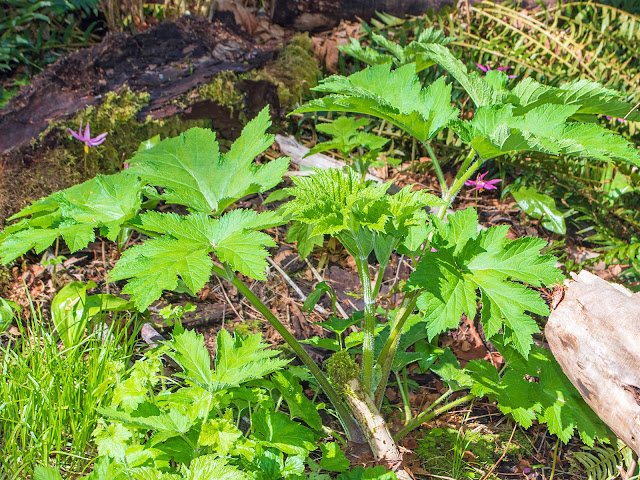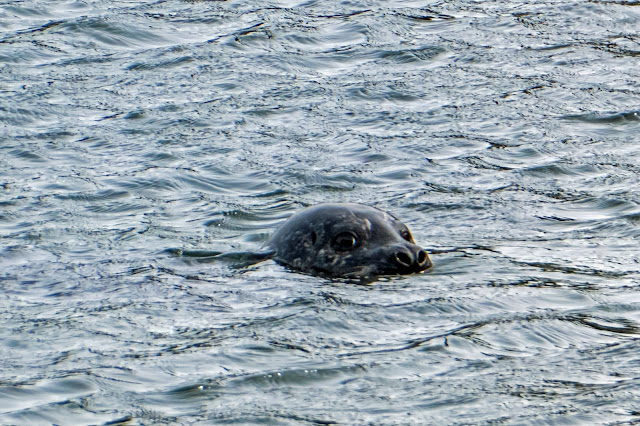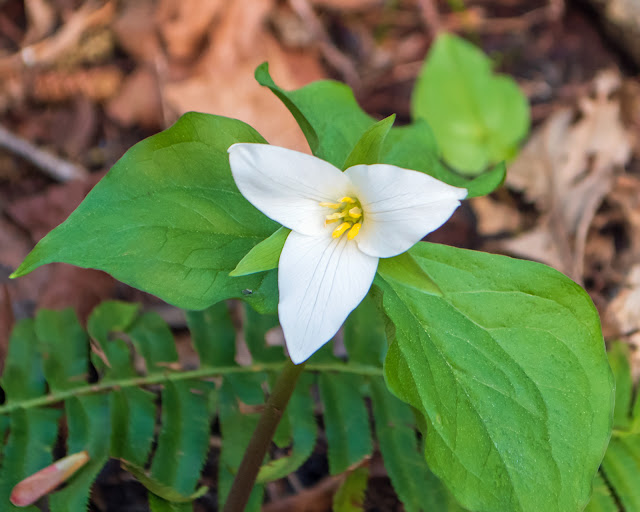Douglas-fir seedlings need light. Down on the forest floor, shaded by thick-leaved salal and evergreen ferns, light is a scarce commodity. That's where nurse logs come in. And nurse stumps; the taller, the better. The seedling reaches up to the light, and sends its roots over the stump and down to the ground below.
 |
| High nurse stump, with mature tree on top. |
The roots of a Douglas-fir*, on the ground, turn out horizontally, except for a main taproot, with a few supporting taproots, which extend downward for up to about 3 metres, depending on the substrate. The lateral roots extend about to the width of the crown.
These two trees are growing in wetlands; their roots, if they had started out on the ground, would be shallow.
Douglas-firs growing in soil frequently exposed to groundwater or runoff will often develop shallow rooting systems. (IronTreeService)
On top of a stump, this pattern has to change. Most of the roots head straight down until they reach the soil, then turn out horizontally.
The supporting stump will eventually rot away, leaving a "ghost". And now, the roots above ground have to become an extension of the trunk, supporting the tree above.
*UPDATE: I'm informed that this tree is a Western hemlock. The root system is similarly shallow, but it will not have a primary taproot.
~~~~~~~~~~~~~~~~~~~~~~~~~~~~
Las plantulitas de abeto de Douglas* necesitan la luz. Y en el bosque donde viven, allá abajo donde las hojas gruesas de
salal y de los helechos perennes cubren todo, apenas penetra uno que otro rayito de sol. De allí la utilidad de troncos caídos, podridos, que sirven de
troncos nodrizas. Si siguen de pie, mejor; y entre más altos, tanto mejor. La plántula, de allí encima, se extiende hacia la luz, y manda sus raices sobre el tronco hasta alcanzar el suelo.
Foto: un tronco nodriza muy alto, con su abeto de Douglas encima.
Las raices de un abeto de Douglas, creciendo en el suelo, se extienden horizontalmente, aparte de una o varias raices primarias, que se hunden en el suelo hasta una profundidad que puede alcanzar 3 metros, según las características del sustrato. Las raices horizontales pueden extenderse hasta aproximadamente lo ancho de la copa del árbol.
Estos dos árboles crecen en un humedal; por lo tanto, en el suelo, sus raices obtendrán poca profundidad.
Los abetos de Douglas que crecen en terreno expuesto a frecuentes inundaciones o desagües muchas veces desarrolan sistemas de raices de poca profundidad. (IronTreeService)
Si el árbol crece encima de un tronco nodriza, este modelo tendrá que cambiar. La mayoría de las raices crecen verticalmente hasta llegar al suelo mineral. Solo entonces, se dan vuelta y crecen horizontalmente.
El tronco que sostiene el árbol nuevo, con el tiempo, se desintegra por completo, dejando un hueco "fantasma". Y ahora las raices al aire toman la función del tronco principal.
Foto: otro tronco nodriza, este con la ardilla embarazada de la semana pasada.
*Puesto al corriente: me informan que el árbol es probablemente un tsuga de Pacífico, Tsuga heterófila. El sistema de raices es parecido, solo que no tiene raiz primaria.


















































